| <
back to congress reports
< photo albums
The 2004 Sigma Pi Sigma National Congress began on Thursday,
October 14th with a truly special event: a visit to the
Trinity Site, where the first atomic bomb was detonated.
The four buses which transported participants to the site
began boarding at 6:30 am, with departure at 7:00am. In
the predawn darkness, society members began to gather around
a table in the lobby of the Hilton Hotel in Albuquerque,
in order to pick up their nametags before finding the appropriate
bus. The early morning air was chill as people began exiting
the hotel and choosing seats on the busses. One of the first
to board the bus I would be taking, I shivered slightly,
and wondered with anticipation what the day would bring.
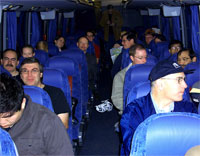 A
movie entitled “The Day After Trinity” was played
on each bus, describing the story of the bomb’s creation.
Unfortunately, technical difficulties interfered on our
bus. We began to have some misgivings about the functionality
of the bus’s televisions when we noticed that a clothespin
was firmly taped in the middle of one screen. In the end,
the sound system proved to be the problem. Without audible
dialogue, the movie was impossible to follow, and the bus
passengers were left to their own thoughts. We were able
to attend an evening screening of "The Day After Trinity"
at the hotel following the trip, however. A
movie entitled “The Day After Trinity” was played
on each bus, describing the story of the bomb’s creation.
Unfortunately, technical difficulties interfered on our
bus. We began to have some misgivings about the functionality
of the bus’s televisions when we noticed that a clothespin
was firmly taped in the middle of one screen. In the end,
the sound system proved to be the problem. Without audible
dialogue, the movie was impossible to follow, and the bus
passengers were left to their own thoughts. We were able
to attend an evening screening of "The Day After Trinity"
at the hotel following the trip, however.
The
skies began to lighten with the first hints of dawn, and
as the orange-glowing disk of the sun slowly rose above
the horizon, a white mist began gather. Soon the bus was
engulfed and the surrounding landscape obscured. My mind
was left to wander, and soon turned to what I knew of the
atomic bomb.
In
high school, I had been shown videos describing the events
leading up to the bombings of Hiroshima and Nagasaki, and
the horrible aftermath that had ensued. For contrast I had
Feynman’s accounts of his days at Los Alamos and the
reaction of the scientists who had worked so diligently
on the Manhattan project upon witnessing the fruits of their
labor. The bomb’s significance in the course of history
is recognized by all, and the appropriateness of its use
still, at times, debated. We have heard of the bomb’s
awesome power and witnessed its explosion on a television
set. Yet, the reality of it can seem distant from the lives
of most Americans. What would it be like to stand in the
actual place where the first atomic bomb was detonated,
and in the house where it was assembled?
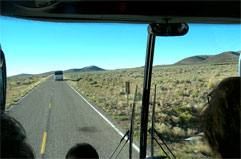 Eventually,
I abandoned my musings and, like many of my fellow bus mates,
succumbed to the desire to sleep. Before long, we had arrived
at the White Sands Missile Range, on which the Trinity site
was located. As the missile range is currently in operation,
the Trinity Site can only be visited on days when there
is no testing scheduled. At the entrance, officials from
the base confirmed that no testing would take place during
the time of our visit. The buses then followed the official’s
car across the wide expanse of the base towards our destination.
The White Sands Missile Range is located on a large flat
stretch of land covered in small shrubs. In the distance,
one can see a range of mountains surrounding the wide plain.
The Trinity site is situated within this great emptiness. Eventually,
I abandoned my musings and, like many of my fellow bus mates,
succumbed to the desire to sleep. Before long, we had arrived
at the White Sands Missile Range, on which the Trinity site
was located. As the missile range is currently in operation,
the Trinity Site can only be visited on days when there
is no testing scheduled. At the entrance, officials from
the base confirmed that no testing would take place during
the time of our visit. The buses then followed the official’s
car across the wide expanse of the base towards our destination.
The White Sands Missile Range is located on a large flat
stretch of land covered in small shrubs. In the distance,
one can see a range of mountains surrounding the wide plain.
The Trinity site is situated within this great emptiness.
When
we entered the base, each person was given a booklet on
the Trinity Site with a short history of the bomb’s
creation and detonation. The very beginning of the booklet
held some interesting information on the current radiation
at the site: a person is exposed to more radiation on a
commercial cross country flight than through spending an
hour at the Trinity Site’s ground zero. The book went
on to describe the experiences of those working at the site,
a general account of the theory behind the bomb, and a description
of the process of building and testing the first bomb. The
final steps of the bomb’s fabrication took place the
MacDonald Ranch House, which we would visit later in our
trip, located a mere two miles from the ground zero site.
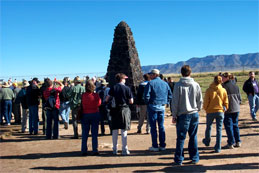 Visiting
the actual site was, in some ways, a slightly surreal experience.
The flat expanse of land stretches out over vast distances,
covered with small shrubs and bearing few features to serve
as landmarks. A clear blue sky stretched from horizon to
horizon, lending the day an almost peaceful atmosphere. Visiting
the actual site was, in some ways, a slightly surreal experience.
The flat expanse of land stretches out over vast distances,
covered with small shrubs and bearing few features to serve
as landmarks. A clear blue sky stretched from horizon to
horizon, lending the day an almost peaceful atmosphere.
The
original atomic bomb was detonated atop a tower, which was
completely destroyed in the blast. At the center of where
this tower once stood, a narrow pyramid of black stones
bears a plaque to mark the site. To one side of this pillar,
a few small stubs of metal embedded in a rock are all that
remain of the tower on which the bomb was placed before
detonation. The area of the desert around the site is fenced
in, to prevent visitors from wandering too far off and losing
themselves in the missile range. On the far side of the
fence, a line of photographs are hung with images of the
bomb’s detonation and the people whose leadership
and hard work had made the bomb a reality.
The
first atomic bomb had left in its wake a large shallow crater
no more than eight feet deep, and within this crater, the
desert floor had been melted into green glass. This glass,
called Trinitite, was initially highly radioactive, and
as a result, much of it was removed. Some pieces were taken
by scientists who had visited the sight shortly after the
explosion, and are still occasionally turning up to this
day. Small pebbles of Trinitite scattered sparsely in the
ground are almost all that remain of the substance at the
actual site. Today, this glass is no longer unusually radioactive,
and the last remnant of the original sheet is buried under
a protective layer of sand, housed under a long, low metal
shed.
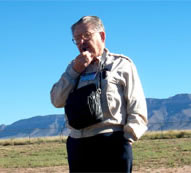 Upon
arriving at the site, the White Sands Missile Range officials
spoke briefly about the history, and Dr. Tom Olsen, the
Sigma Pi Sigma Historian, gave a brief welcome to the visitors.
Then, we had the unique experience of hearing Dr. Worth
Seagondollar speak at the site where the blast had occurred
almost sixty years before. Dr. Seagondollar had been a member
of a team running tests on the Plutonium to be used in the
bomb, and had witnessed the first bomb’s detonation.
He spoke of how work on the Manhattan project was considered
a valuable and unique opportunity for young scientists,
as they would be working in the vicinity of some of the
most prominent physicist of the day. He recounted some of
his experiences on the site prior to the bomb’s detonation
and after the explosion. Hearing the story firsthand of
a man who had worked on the project seemed to bridge the
gap between past and present, and emphasize the historical
significance of where we were standing. Upon
arriving at the site, the White Sands Missile Range officials
spoke briefly about the history, and Dr. Tom Olsen, the
Sigma Pi Sigma Historian, gave a brief welcome to the visitors.
Then, we had the unique experience of hearing Dr. Worth
Seagondollar speak at the site where the blast had occurred
almost sixty years before. Dr. Seagondollar had been a member
of a team running tests on the Plutonium to be used in the
bomb, and had witnessed the first bomb’s detonation.
He spoke of how work on the Manhattan project was considered
a valuable and unique opportunity for young scientists,
as they would be working in the vicinity of some of the
most prominent physicist of the day. He recounted some of
his experiences on the site prior to the bomb’s detonation
and after the explosion. Hearing the story firsthand of
a man who had worked on the project seemed to bridge the
gap between past and present, and emphasize the historical
significance of where we were standing.
After
Dr. Seagondollar finished speaking, the crowd dispersed
to view the site and ask questions of the guides from the
missile base. After an hour, we again boarded the busses
and proceeded to the McDonald Ranch house, a mere two miles
away. A room of this house had been turned into a makeshift
clean room in which the final steps of the assembly of the
bomb’s devices were carried out. The house itself
is an unprepossessing, one-story, square building with a
small porch at the front entrance. The door frame still
bears painted messages to wipe one’s feet before entering,
remnants from the days when the house contained the clean
room. Inside the rooms of the house are a series of images
and written documents detailing the house’s history.
Outside, one can see the water tank were those who worked
at the site would swim during the summer.
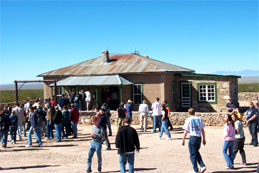 After
we had spending some time at the McDonald’s Ranch
site, two of the buses departed for the Owl Café
for lunch, while the remaining two buses took their passengers
to visit a nearby nature preserve. At the Owl Café,
the trip attendees enjoyed chili cheeseburgers and each
other’s company for lunch. Afterwards, some of the
students on the trip wandered off and managed to find ice
cream before boarding the buses for the final time. At 1:45,
the buses departed the Owl Café for the Hilton. The
trip was truly a unique experience. As the White Sands Missile
Range is an active facility, the Trinity site is only open
to visitors twice a year, in April and October. After
we had spending some time at the McDonald’s Ranch
site, two of the buses departed for the Owl Café
for lunch, while the remaining two buses took their passengers
to visit a nearby nature preserve. At the Owl Café,
the trip attendees enjoyed chili cheeseburgers and each
other’s company for lunch. Afterwards, some of the
students on the trip wandered off and managed to find ice
cream before boarding the buses for the final time. At 1:45,
the buses departed the Owl Café for the Hilton. The
trip was truly a unique experience. As the White Sands Missile
Range is an active facility, the Trinity site is only open
to visitors twice a year, in April and October.
The
stories of the Manhattan project provide a unique look into
a group of scientists working towards a common goal: to
help defend their country in the midst of war. Yet they
were also driven by a desire to discover the possibilities
of new technology and the solution to a pressing problem.
The Sigma Pi Sigma and SPS members who attended this trip
had the exiting experience of witnessing an important piece
of scientific and American history first hand.
<
back to congress reports
< photo albums
Note:
Facts concerning the site were taken from the “Trinity
Site” booklet provided on the tour.
|
 A
movie entitled “The Day After Trinity” was played
on each bus, describing the story of the bomb’s creation.
Unfortunately, technical difficulties interfered on our
bus. We began to have some misgivings about the functionality
of the bus’s televisions when we noticed that a clothespin
was firmly taped in the middle of one screen. In the end,
the sound system proved to be the problem. Without audible
dialogue, the movie was impossible to follow, and the bus
passengers were left to their own thoughts. We were able
to attend an evening screening of "The Day After Trinity"
at the hotel following the trip, however.
A
movie entitled “The Day After Trinity” was played
on each bus, describing the story of the bomb’s creation.
Unfortunately, technical difficulties interfered on our
bus. We began to have some misgivings about the functionality
of the bus’s televisions when we noticed that a clothespin
was firmly taped in the middle of one screen. In the end,
the sound system proved to be the problem. Without audible
dialogue, the movie was impossible to follow, and the bus
passengers were left to their own thoughts. We were able
to attend an evening screening of "The Day After Trinity"
at the hotel following the trip, however. Eventually,
I abandoned my musings and, like many of my fellow bus mates,
succumbed to the desire to sleep. Before long, we had arrived
at the White Sands Missile Range, on which the Trinity site
was located. As the missile range is currently in operation,
the Trinity Site can only be visited on days when there
is no testing scheduled. At the entrance, officials from
the base confirmed that no testing would take place during
the time of our visit. The buses then followed the official’s
car across the wide expanse of the base towards our destination.
The White Sands Missile Range is located on a large flat
stretch of land covered in small shrubs. In the distance,
one can see a range of mountains surrounding the wide plain.
The Trinity site is situated within this great emptiness.
Eventually,
I abandoned my musings and, like many of my fellow bus mates,
succumbed to the desire to sleep. Before long, we had arrived
at the White Sands Missile Range, on which the Trinity site
was located. As the missile range is currently in operation,
the Trinity Site can only be visited on days when there
is no testing scheduled. At the entrance, officials from
the base confirmed that no testing would take place during
the time of our visit. The buses then followed the official’s
car across the wide expanse of the base towards our destination.
The White Sands Missile Range is located on a large flat
stretch of land covered in small shrubs. In the distance,
one can see a range of mountains surrounding the wide plain.
The Trinity site is situated within this great emptiness.
 Visiting
the actual site was, in some ways, a slightly surreal experience.
The flat expanse of land stretches out over vast distances,
covered with small shrubs and bearing few features to serve
as landmarks. A clear blue sky stretched from horizon to
horizon, lending the day an almost peaceful atmosphere.
Visiting
the actual site was, in some ways, a slightly surreal experience.
The flat expanse of land stretches out over vast distances,
covered with small shrubs and bearing few features to serve
as landmarks. A clear blue sky stretched from horizon to
horizon, lending the day an almost peaceful atmosphere.
 Upon
arriving at the site, the White Sands Missile Range officials
spoke briefly about the history, and Dr. Tom Olsen, the
Sigma Pi Sigma Historian, gave a brief welcome to the visitors.
Then, we had the unique experience of hearing Dr. Worth
Seagondollar speak at the site where the blast had occurred
almost sixty years before. Dr. Seagondollar had been a member
of a team running tests on the Plutonium to be used in the
bomb, and had witnessed the first bomb’s detonation.
He spoke of how work on the Manhattan project was considered
a valuable and unique opportunity for young scientists,
as they would be working in the vicinity of some of the
most prominent physicist of the day. He recounted some of
his experiences on the site prior to the bomb’s detonation
and after the explosion. Hearing the story firsthand of
a man who had worked on the project seemed to bridge the
gap between past and present, and emphasize the historical
significance of where we were standing.
Upon
arriving at the site, the White Sands Missile Range officials
spoke briefly about the history, and Dr. Tom Olsen, the
Sigma Pi Sigma Historian, gave a brief welcome to the visitors.
Then, we had the unique experience of hearing Dr. Worth
Seagondollar speak at the site where the blast had occurred
almost sixty years before. Dr. Seagondollar had been a member
of a team running tests on the Plutonium to be used in the
bomb, and had witnessed the first bomb’s detonation.
He spoke of how work on the Manhattan project was considered
a valuable and unique opportunity for young scientists,
as they would be working in the vicinity of some of the
most prominent physicist of the day. He recounted some of
his experiences on the site prior to the bomb’s detonation
and after the explosion. Hearing the story firsthand of
a man who had worked on the project seemed to bridge the
gap between past and present, and emphasize the historical
significance of where we were standing. After
we had spending some time at the McDonald’s Ranch
site, two of the buses departed for the Owl Café
for lunch, while the remaining two buses took their passengers
to visit a nearby nature preserve. At the Owl Café,
the trip attendees enjoyed chili cheeseburgers and each
other’s company for lunch. Afterwards, some of the
students on the trip wandered off and managed to find ice
cream before boarding the buses for the final time. At 1:45,
the buses departed the Owl Café for the Hilton. The
trip was truly a unique experience. As the White Sands Missile
Range is an active facility, the Trinity site is only open
to visitors twice a year, in April and October.
After
we had spending some time at the McDonald’s Ranch
site, two of the buses departed for the Owl Café
for lunch, while the remaining two buses took their passengers
to visit a nearby nature preserve. At the Owl Café,
the trip attendees enjoyed chili cheeseburgers and each
other’s company for lunch. Afterwards, some of the
students on the trip wandered off and managed to find ice
cream before boarding the buses for the final time. At 1:45,
the buses departed the Owl Café for the Hilton. The
trip was truly a unique experience. As the White Sands Missile
Range is an active facility, the Trinity site is only open
to visitors twice a year, in April and October.